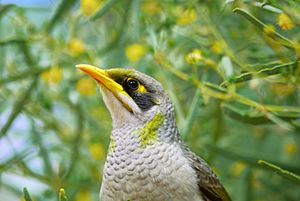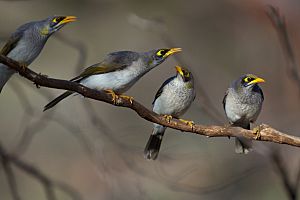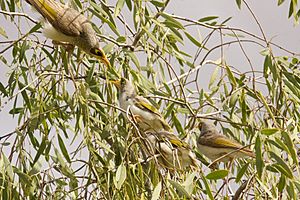Yellow-throated miner facts for kids
Quick facts for kids Yellow-throated miner |
|
|---|---|
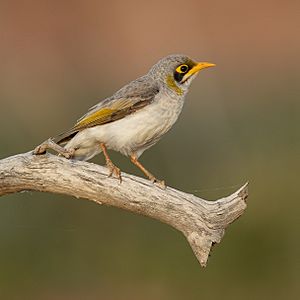 |
|
| Conservation status | |
| Scientific classification | |
| Genus: |
Manorina
|
| Species: |
flavigula
|
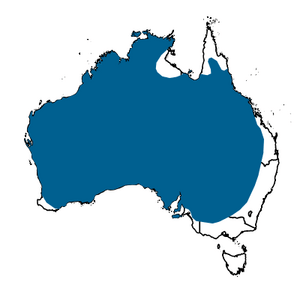 |
|
| Yellow-throated miner range | |
The yellow-throated miner (Manorina flavigula) is a type of bird. It is a honeyeater and lives only in Australia. People sometimes call it the white-rumped miner. This is because it has a clear white patch on its back, near its tail. This white patch helps tell it apart from other similar birds.
Yellow-throated miners are medium-sized birds. They are mostly grey with yellow markings on their throat. They also have yellow legs and bare yellow skin around their eyes. The name 'miner' comes from the word myna. These birds were named because they look a bit like the common myna from India. However, common mynas are from the starling family. They are not closely related to the honeyeater family.
Yellow-throated miners eat many things. Their diet includes insects, nectar from flowers, pollen, and seeds. They are found in open woodlands and scrublands across most of Australia. These birds live in groups. They are social, noisy, and protect their area from other birds. Their behavior is much like their close relative, the noisy miner.
Contents
About the Yellow-throated Miner
In 1840, a scientist named John Gould gave the yellow-throated miner its scientific name, Manorina flavigula. This name means 'thin-nostrilled, yellow-throated' bird. It belongs to the family of honeyeaters, called Meliphagidae. This family also includes Australian chats.
The yellow-throated miner is part of the Manorina group of birds. This group includes three other Australian miners:
- The bell miner (M. melanophrys)
- The noisy miner (M. melanocephala)
- The endangered black-eared miner (M. melanotis)
The yellow-throated, black-eared, and noisy miners look very much alike. Scientists once put them in a different group called Myzantha. Genetic studies show that the closest relatives to the Manorina group are the Melidectes honeyeaters from New Guinea.
There are five different types, or subspecies, of the yellow-throated miner. These subspecies have small differences in color and size. For example, one type, M. f. obscura, is known for being darker. Another type, M. f. lutea, is more yellow.
What They Look Like
The yellow-throated miner looks very similar to the noisy and black-eared miners. It is a medium-sized honeyeater. It grows to be about 22 to 28 centimetres (8.7 to 11.0 inches) long. Adult birds weigh between 50 and 61 grams (1.8 to 2.2 ounces).
These miners have dark grey feathers on their back. Their wings are dark grey with some yellow highlights. Their belly feathers are light grey to white. The feathers around their eyes are black. Their beak, the bare skin around their eyes, and their legs are bright yellow. Their eyes are brown.
Young birds have soft, light grey chests without the patterns seen on adults. A key way to tell yellow-throated miners apart is their clean white rump. The noisy and black-eared miners have grey all the way down their back. This white rump is easy to see when the yellow-throated miner flies away. This helps people identify them in the wild.
Yellow-throated miners also have different amounts of yellow. This yellow can be above and below their beak, on their forehead, chin, and throat. This is different from noisy miners, which have white above their beak. Pure black-eared miners have darker feathers on their lower jaw than on their throat.
Where They Live
The yellow-throated miner lives in more places than any other Manorina species. You can find them across most of Australia. They are not found east of the Great Dividing Range, on Cape York Peninsula, or in the very dry parts of Central Australia.
These birds mostly live in dry and semi-dry areas. However, they can also be found in warmer and tropical places. They live in woodlands and scrublands. This includes areas with acacia, eucalyptus, and casuarina trees. They also like areas where the habitat has been changed, like along roads or next to cleared land. They can live in areas where trees are growing back.
Yellow-throated miners like some tree cover. But they will go into open areas like pastures more often than noisy miners.
Behavior and Social Life
Scientists have not studied the yellow-throated miner as much as the noisy miner or bell miner. But their behavior seems similar to other Manorina birds. They prefer open forests and can live well in changed habitats. Yellow-throated miners might move around more than other miner species. However, they stay in some places all year. They are often seen in larger groups when they are not breeding.
Social Groups and Being Aggressive
Yellow-throated miners have a complex social life. They can live in groups of up to 50 birds. Often, they are found in smaller groups of about a dozen birds. Sometimes, they are seen in pairs or alone. They seem to have a social structure similar to noisy miners. They share many calls and ways of interacting. Their calls are higher pitched than noisy miner calls. But you can still tell it's a miner.
These birds are very watchful. They are often the first to warn others when a predator is near. Like other miners, they are known to be very aggressive towards other birds. They especially target smaller insect-eating birds and honeyeaters. Yellow-throated miners have been seen taking over small patches of trees along roads. This can block smaller birds from moving through.
Yellow-throated miners, like their relatives, have been linked to fewer bird species in disturbed areas. This is because they drive many birds away. They are not afraid to attack larger birds. But surprisingly, they sometimes share their territory with grey butcherbirds and pied butcherbirds. They even nest close to these birds. This might be because they help each other defend against predators. Yellow-throated miners are very noisy when a predator approaches.
Even though they are often aggressive, yellow-throated miners have also been seen feeding with other honeyeaters. This includes noisy miners, white-plumed honeyeaters, and blue-faced honeyeaters.
What They Eat
Like most honeyeaters, yellow-throated miners eat a variety of foods. This includes insects, nectar from flowers, and sometimes fruit. They usually feed in small groups of five to ten birds. Sometimes they feed in pairs, or in large groups. They may also feed with other honeyeater species.
Yellow-throated miners look for food in the treetops. They poke into flowers for nectar. They also pick spiders and insects off leaves and bark. They catch insects while flying. They also look for insects on the ground, under leaves and stones. About 65% to 70% of their diet is insects, and 30% to 35% is nectar. Young chicks eat almost only insects until they are old enough to fly and start exploring flowers.
Reproduction and Life Cycle
Yellow-throated miners often breed in groups, with other birds helping. But they have also been seen breeding in pairs. Pairs that breed without helpers often have less success. They can breed throughout the year. However, it is most common from August to October. They often have more than one group of chicks in a year.
Their nest is shaped like a cup or bowl. It is built in the fork of a tree, hidden by leaves. The nest is made of woven twigs and grasses. It has a soft lining inside, often made of wool. It is similar to a noisy miner's nest, but stronger.
A female usually lays three or four eggs. Sometimes, they lay two or five eggs. The eggs are pink-buff with spots, mostly on the larger end. Females usually sit on the eggs to keep them warm. This is called incubation. It takes about 15 to 16 days for the eggs to hatch. Both parents and any helpers feed the young birds in the nest. Up to seven birds have been seen helping at a nest. Helpers are usually young or single males.
Sometimes, other birds lay their eggs in the miner's nest. This is called parasitism. The pallid cuckoo or common koel might do this. Up to 12% of nests have been found with cuckoo eggs.
Hybridization and the Black-eared Miner
Yellow-throated miners can breed with both noisy miners and the endangered black-eared miners. However, breeding with noisy miners seems rare. Breeding with black-eared miners is a big problem for the black-eared miner's survival.
Black-eared miners used to live in thick, old mallee forests. Yellow-throated miners did not often meet them. But in the mid-1900s, many mallee forests were cleared. Yellow-throated miners like disturbed land. So, they moved into these newly opened areas. They started breeding with the black-eared miners.
Before 1950, the two species looked very different. But now, because of breeding together, there are many birds that are a mix of both. To protect the pure black-eared miners, sometimes yellow-throated miners are removed from areas where the black-eared miners live.
See also
 In Spanish: Mielero goligualdo para niños
In Spanish: Mielero goligualdo para niños



